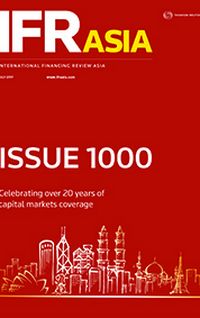Asian issuers and investors took on new significance in the global capital markets in 2014, making it clear that the region is no longer dependent on western money. Alibaba’s world-record IPO, followed up with a jumbo bond, proved that Asia’s homegrown champions can stand shoulder to shoulder with the world’s biggest and best-known companies. Bank of China showcased the firepower of Asian investors with its world-record bank capital offering.
International bond sales soared another 30% to more than US$200bn from Asia, excluding Japan and Australasia. Dim Sum and Kangaroo bond issues each hit new highs, and the first Panda bond hit the road, aptly, from a German carmaker.
IFR Asia 830 – February 8, 2014
Hurdles limit SBI’s record share sale
India’s biggest lender completed a record institutional share placement last week, but a combination of choppy emerging markets, aggressive pricing and selling restrictions meant the Rs80bn (US$1.3bn) deal fell short of its target.
State Bank of India’s qualified institutional placement was the largest since the format was introduced in 2006 and was a welcome capital boost for the state-owned lender.
While the size stood out at a time when international investors were shunning emerging markets, SBI had to temper its ambitions, paring the deal to 51.3m new shares from 58.9m and pricing at the bottom of the Rs1,565–Rs1,596 target range. The transaction would have totalled Rs94bn if it had sold the full number at the top of the range.
Some market participants argued the 0%–2% discount to the last traded price of Rs1,596.60 on January 28, when the placement was launched, was too thin in volatile trading conditions. Rules restricting the number of investors were a further complication.
“We lost some demand as we couldn’t allocate under the 49-account restriction. The discount was also too tight,” a source said. Under the Companies Act, any share placement to more than 49 investors qualifies as a public issue, requiring the necessary disclosures to be made.
Bankers were hoping SBI would be amenable to selling the shares to more investors as the bank, technically, was formed under the State Bank of India Act and the rules of the Companies Act are not applicable to it. The issuer, however, decided to play it safe.
Of the shares made available, around 70% went to domestic investors and the rest went to international long-only funds.
State-owned Life Insurance Corp of India bought shares totalling US$450m – more than a third of the offering.
IFR Asia 838 – April 5, 2014
Pakistan set for dollar bond return
The Islamic Republic of Pakistan is marketing its first US dollar bond in seven years in a move that makes it one of the lowest-rated countries to sell international debt.
Pakistan met investors in Asia last week and will continue meetings in the US on Monday to discuss a potential 144A/Reg S US dollar issue. Bank of America Merrill Lynch, Barclays, Citigroup and Deutsche Bank are the lead managers.
Pakistan is rated Caa1/B–, and a successful debt sale will mark a new frontier for Asia. The low ratings, economic uncertainties, and considerable geopolitical risks in a country entrenched in recent global conflicts, can be overcome, bankers and investors say, if Pakistan offers a compelling yield.
“If the coupon is attractive enough, it could attract enough interest from investors unrestricted by credit rating,” said a Hong Kong-based portfolio manager.
Moody’s downgraded Pakistan to Caa1 from B3 in July 2012, citing the country’s external payments position as a result of a rising trade deficit and a decline in capital inflows.
Standard & Poor’s, however, affirmed its B‑ rating on Pakistan long-term debt just last week, citing the government’s reform efforts and a US$6.7bn three-year loan from the International Monetary Fund. The IMF financing requires Pakistan to accomplish certain economic reforms, including a longstanding promise to privatise loss-making state companies.
Sri Lanka, rated B1/B+/BB–, is the only non-investment-grade sovereign in Asia to have issued bonds this year. The previous one was a US$1.5bn offering from B1/BB–/B+ rated Mongolia in November 2012.
IFR Asia 862 – September 20, 2014
Alibaba’s IPO finally delivers
A conservative valuation stance and a partly superstitious approach to pricing, even in the face of overwhelming demand, ensured the long-awaited US$21.8bn NYSE IPO of Alibaba Group was a mostly seamless exercise last week.
Ahead of Friday’s much-anticipated NYSE debut, the Chinese ecommerce giant set the offering of 320.1m American depositary shares at US$68, the high end of the US$66–$68 range. The range was increased Monday from US$60–$66 at launch, but the number of shares sold stayed the same throughout the marketing period.
Deal sources said Thursday that the IPO could have priced much higher than US$68 due to overwhelming demand for the shares, describing the revised marketing range as largely “cosmetic”. In fact, Alibaba is thought to have settled on the US$68 price some weeks ago, in part because eight is considered a lucky number in Chinese culture. The IPO also launched on September 8 and stuck to its original schedule to price on September 18.
Ultimately, Alibaba is likely to rank as the biggest IPO in history. The exercise of the underwriters’ 15% overallotment will push the total size to US$25.0bn, surpassing the US$22.1bn IPO of Agricultural Bank of China in 2010 and the US$22.0bn IPO of ICBC in 2006.
The final price valued Alibaba at US$167.6bn. Trading had yet to begin at the time of writing, but some analysts expect the valuation to top US$200bn (or roughly US$81 a share) on debut.
To view all special report articles please click here and to see the digital version of this report please click here .
To purchase printed copies or a PDF of this report, please email gloria.balbastro@thomsonreuters.com .


